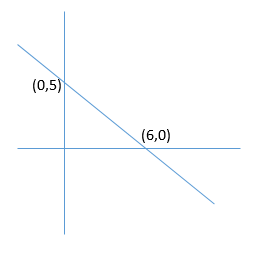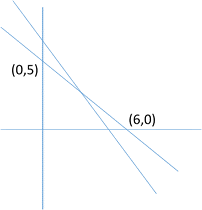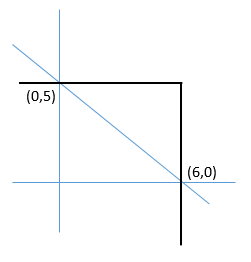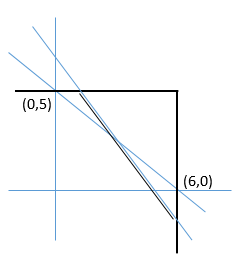Explanation
This question involves a region in the xy plane. Since the inequality is
less than or equal to, the region will be defined by everything that is left
and below the line
 . That line can be put into
. That line can be put into
 form by
subtracting 5x from both sides of the equation and dividing by 6, giving us
form by
subtracting 5x from both sides of the equation and dividing by 6, giving us

On this line, when x=0,
y=5; 5 is the y-intercept. The line slopes down to the right at a moderate angle
and crosses the x-axis when y is zero, so that
 and
and
 . Indeed, while the line format
. Indeed, while the line format
 is generally
useful, the format
is generally
useful, the format
 allows us to
see the x- and y-intercepts easily. We would go ahead and sketch the line on our noteboard:
allows us to
see the x- and y-intercepts easily. We would go ahead and sketch the line on our noteboard:

On to the data statements, evaluating them first
separately.
Statement (1) describes a similar but different line to
the border of Region R. It can quickly be judged insufficient on the grounds
that it is a line with a different slope than the boundary line of region R.
You might react, "Wait a minute. The question said (r, s) was a point--why are we talking about a line of r and s, then?" We are talking about a line because Statement (1) has not
uniquely defined r and s for us. (r, s) is, indeed, a point, but on the basis of
 , we can only narrow down the field of
possibilities. A line is a collection of points, and the line
, we can only narrow down the field of
possibilities. A line is a collection of points, and the line
 describes all
the possible locations of (r, s). If
this line lies either wholly inside or wholly outside region R, then we will be
able to answer the question of whether (r,
s) is inside the region for all possible cases. On the other hand, if the
line of possible locations for (r, s)
is partly inside and partly outside region R, then we will not be able to
answer the question definitively, because in some possible cases (r, s) is inside region R and in other
possible cases it's outside region R. This latter possibility is, in fact, the
reality. The line
describes all
the possible locations of (r, s). If
this line lies either wholly inside or wholly outside region R, then we will be
able to answer the question of whether (r,
s) is inside the region for all possible cases. On the other hand, if the
line of possible locations for (r, s)
is partly inside and partly outside region R, then we will not be able to
answer the question definitively, because in some possible cases (r, s) is inside region R and in other
possible cases it's outside region R. This latter possibility is, in fact, the
reality. The line
 has y-intercept of 6 and an x-intercept of 5; the values are
switched from the intercepts of the border of region R. As you can sketch or
imagine, the two lines cross like an elongated diagonal letter X.
has y-intercept of 6 and an x-intercept of 5; the values are
switched from the intercepts of the border of region R. As you can sketch or
imagine, the two lines cross like an elongated diagonal letter X.

Indeed, the only way a line would not cross the border of region R would be for that line to be
parallel to that border, since any pair of non-parallel lines will cross
eventually. By this alternate train of thought, you could compute the slope of
this line as
 , using the intercepts and the fact that slope is
, using the intercepts and the fact that slope is
 . Statement (1) is insufficient.
. Statement (1) is insufficient.
Statement (2) describes the range of possibilities for the
point (r, s) with two boundaries. Since each boundary is parallel to an axis,
Statement (2) describes a box-like corner boundary that includes everything to
the left and down similar to region R.

The upper-right triangle is permitted by Statement (2), as
it's inside the box, but it's outside of region R. Meanwhile, the region
described by Statement (2) also includes plenty of points within region R. Once
again, based on the data in this statement, the point could be either inside or
outside of region R, so we are unable to answer the question definitively.
Statement (2) is insufficient.
We must combine the statements. When both Statements are
true, the field of possibilities is significantly reduced. The point must now
be on the line
 and within
the rectangular boundary:
and within
the rectangular boundary:

The remaining line segment still has a portion inside of
region R and outside of region R. So the statements together are insufficient.
We can double-check and make sure we haven't drawn incorrectly by cases. The
point (5,0) is on the line
 and it satisfies the condition
and it satisfies the condition
 . That point is inside region R. It's a little
trickier to come up with a point that is in the short segment above region R. Since
. That point is inside region R. It's a little
trickier to come up with a point that is in the short segment above region R. Since
 , we can choose a value of s that is near 5 but less: say,
, we can choose a value of s that is near 5 but less: say,
 . Then
. Then
 ,
,
 ,
,
 . So
. So
 is on the
line segment. If we plug r=1 into the
boundary line, we get
is on the
line segment. If we plug r=1 into the
boundary line, we get
 , so
, so
 and
and
 . Since
. Since
 is less than
is less than
 , the possible (r,s)
value we are looking at is on the line described in Statement (1), inside the
boundary described by Statement (2), and outside (above) the region R.
, the possible (r,s)
value we are looking at is on the line described in Statement (1), inside the
boundary described by Statement (2), and outside (above) the region R.
The correct answer is (E).
If you believe you have found an error in this question or explanation, please contact us and include the question title or URL in your message.